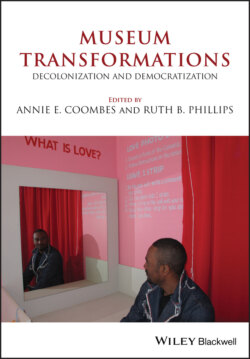Читать книгу Museum Transformations - Группа авторов - Страница 62
Notes
Оглавление1 1 In this chapter, I use “Holocaust museum” to signify institutions that memorialize the Jewish genocide under the Nazi regime, and “holocaust museum” to signify similar museums that narrate genocides and massacres of diverse communities.
2 2 Prominent professional associations for such museums include the International Coalition for the Sites of Conscience and the ICOM Committee for Memorial Museums in Remembrance of the Victims of Public Crimes. Many museum design consultants who worked on the pioneering Holocaust museums in the United States and Israel have had subsequent careers designing such museums for other communities. Prominent among these are Ralph Appelbaum Associates, the largest museum design firm in the world, whose projects include the United States Holocaust Memorial Museum in Washington, DC, the Holocaust Museum in Houston, the Canadian Museum for Human Rights in Winnipeg, and the Vietnam Era Education Center in Washington, DC. Michael Berenbaum, who was director of the Holocaust Museum in Washington, has been involved in the Holocaust Center in Skopje, Macedonia, the Holocaust Museum in Illinois, and Memoria y Tolerencia, Mexico. Jeshajahu Weinberg, whose museum work in Israel led to his appointment as Director of the United States Holocaust Museum, was also involved in Jewish museum projects in Warsaw and Berlin and was a consultant on the Khalsa Heritage project discussed in this chapter. Professional networks of prominent designers, architects, and museum content creators who work internationally have given the holocaust museum a recognizable appearance and narrative structure as it spreads across the globe.
3 3 An instructive study of this in relation to the United States Holocaust Museum in Washington, DC is presented in Linenthal (1995). See also Young’s (1993) study of Holocaust memorials across Europe, Israel, and North America.
4 4 Even more cynically, one might say that the establishment of memorial museums has become a useful political ritual for regimes which need to signal the end of one era (an era of oppression) and the arrival of another era (an era of recuperation) through the making of such a museum. Since the very act of memorializing suggests the pastness of the things memorialized, a museum project of this type can even be used to suggest the historical distance from an era or power structure which in fact continues to endure in the present day. In Cambodia, for instance, memorials went up at many sites of internment and mass killings, even as former Khmer Rouge officials remained powerful in the new Cambodian government. Closer to home, in India victims of the toxic gas leak from the Union Carbide factory in Bhopal – said to be the worst industrial disaster in history – received pitifully inadequate compensation while Union Carbide’s managers went free; in an ill-advised gesture of “closure,” Union Carbide offered to fund a memorial. As Bhopal’s survivors continue to struggle against unfeeling authorities and their own compromised health, they have rejected the offer of this memorial from above in favor of a more modest exhibition of their own devising which will be part of their advocacy for justice (see Lakshmi 2012).
5 5 Fenech (2000). For a fuller history of the Singh Sabha movement, see Oberoi (1994, chs. 4–6).
6 6 Indeed, the Singh Sabha even constituted a category of “living martyrs” for people who “gave” their lives not by dying but by selflessly devoting themselves to community service. See Fenech (2000, 14–15) for a discussion of the zinda shahid, or living martyr who faces persecution as he pursues his goal. As an example of such a shahid, Fenech discusses the life of Bhai Takht Singh (1860–1933) who pioneered the cause of Sikh female education.
7 7 For an analysis of Sikh militant discourse which produced parallelisms between the political present and the historical past, see Das (1992).
8 8 Letter to Vini Mahajan, Chief Executive Officer, Anandpur Sahib Foundation, January 26, 1999.
9 9 Minutes of the Meeting held under the Chairmanship of Chief Minister of Punjab in regard to Presentation of the Model of KHMC, August 7, 1998.
10 10 Moshe Safdie, fax to D. S. Jaspal, November 14, 1997, Anandpur Sahib Foundation, File: Correspondence with Moshe Safdie.
11 11 For brief account of the most prolific of these artists, Kripal Singh, see Randhawa (1978–1979).
12 12 For a discussion of some of the controversial additions to the Central Sikh Museum, see Chopra (2013).
13 13 For a brief history of the establishment of the Norbulingka Institute, see Yeshi (2006).
14 14 A section of the Tibetan exile intelligentsia is critical of what they call a “New Age” makeover of Tibet. Prominent among these critics is Jamyang Norbu; see Norbu (2004) for several essays expressing this viewpoint.
15 15 See Jamyang Norbu (2004) for a trenchant criticism of the impulses that marginalize the resistance movement in the history of Tibet.
16 16 For descriptions of the other museums in Dharamsala, see Harris (1999, 2012) and Singh (2010).
17 17 Ginguld was one of the founders of a nonprofit organization called the Israeli Friends of the Tibetan People, which fostered capacity building for Tibetan exiles through educational exchange and training in agricultural technology. Ginguld is currently the CEO of Airjaldi, a social enterprise that brings wireless Internet connectivity to the Dharamsala region.
18 18 For a lively account of this meeting, see Kamenetz (1994).
19 19 Aran (2005, 202) cites passages from My Land and My People, published by the Dalai Lama in 1962 (Ngawang Lobsang Yishey Tenzing Gyatso 1962).
20 20 While the Dalai Lama may have been inspired by Yad Vashem, on his visit there he had angered Israelis by saying that it was his belief that “Even in such people (Nazis) deep down there is a seed of human compassion” (Freelance Star, March 22, 1994).
